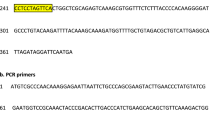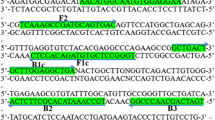Abstract
The Fusarium genus causes devastating plant diseases worldwide, in which Fusarium oxysporum is the most serious crop pathogen. Disease monitoring is the basis of integrated pest management of any disease. The lack of rapid, accurate, and reliable device to detect and identify plant pathogens is one of the main limitations in integrated disease management. This study describes an efficient and quantifiable diagnosis method for the specific detection of F. oxysporum f. sp. cubense (Foc) race 4 in field-infected banana. With the optimized PCR parameters using the SCAR (sequence characterized amplified region) primers FocSc-1/FocSc-2 and a real-time PCR strategy, the developed method showed high reproducibility and was very sensitive to detect extremely low quantities of Foc genomic DNA (gDNA). We also found that Foc gDNA in severely symptomatic banana pseudostems and leaves were 6946-fold and 26.69-fold more than in those of mild-symptomatic banana, respectively.




Similar content being viewed by others
References
Beckman, C. H. (1990). Host responses to the pathogen. In R. C. Ploetz (Ed.), Fusarium Wilt of Banana (pp. 107–114). St. Paul: APS Press.
Bookout, A. L., & Mangelsdorf, D. J. (2003). Quantitative real-time PCR protocol for analysis of nuclear receptor signaling pathways. Nuclear Receptor Signaling, 1, e012.
Clercq, D. D., Ceustermans, A., Heyndrickx, M., Coosemans, J., & Ryckeboer, J. (2007). A rapid monitoring assay for the detection of Salmonella spp. and Salmonella Senftenberg strain W775 in composts. Journal of Applied Microbiology, 103, 2102–2112.
Daniells, J., Davis, D., Peterson, R., & Pegg, K. (1995). Goldfinger: not as resistant to sigatoka/yellow sigatoka as first thought. Infomusa, 4, 6.
Demontis, M. A., Cacciola, S. O., Orrù, M., Balmas, V., Chessa, V., Maserti, B. E., Mascia, L., Raudino, F., di San, M., Lio, G., & Migheli, Q. (2008). Development of real-time PCR systems based on SYBR® Green I and TaqMan® technologies for specific quantitative detection of Phoma tracheiphila in infected Citrus. European Journal of Plant Pathology, 120, 339–351.
Dias, A. K. K., Aoki, S. M., Garcia, J. F., & Nunes, C. M. (2007). Taenia solium and Taenia saginata: Identification of sequence characterized amplified region (SCAR) markers. Experimental Parasitology, 117, 9–12.
Dita, M. A., Waalwijk, C., Buddenhagen, I. W., Souza, M. T., Jr., & Kema, G. H. J. (2010). A molecular diagnostic for tropical race 4 of the banana fusarium wilt pathogen. Plant Pathology, 59, 348–357.
FAO (2011). FAO Yearbook (Production). Food and Agriculture Organization of the United Nations.
Forsyth, L. M., Smith, L. J., & Aitken, E. A. B. (2006). Identification and characterization of non-pathogenic Fusarium oxysporum capable of increasing and decreasing Fusarium wilt severity. Mycological Research, 110, 929–935.
Fungaro, M. H. P., Vissotto, P. C., Sartori, D., Vilas-Boas, L. A., Furlaneto, M. C., & Taniwaki, M. H. (2004). A molecular method for detection of Aspergillus carbonarius in coffee beans. Current Microbiology, 49, 123–127.
Groenewald, S., Van Den Berg, N., Marasas, W. F., & Viljoen, A. (2006). The application of high-throughput AFLP’s in assessing genetic diversity in Fusarium oxysporum f. sp. cubense. Mycological Research, 110, 297–305.
Hwang, S. C., & Ko, W. H. (2004). Cavendish banana cultivars resistant to Fusarium wilt acquired through somaclonal variation in Taiwan. Plant Disease, 88, 580–588.
Jurado, M., Vázquez, C., Marín, S., Sanchis, V., & González-Jaéna, M. T. (2006). PCR-based strategy to detect contamination with mycotoxigenic Fusarium species in maize. Systematic and Applied Microbiology, 29, 681–689.
Klemsdal, S. S., & Elen, O. (2006). Development of a highly sensitive nested-PCR method using a single closed tube for detection of Fusarium culmorum in cereal samples. Letters in Applied Microbiology, 42, 544–548.
Lin, Y. H., Chang, J. Y., Liu, E. T., Chao, C. P., Huang, J. W., & Chang, P. F. L. (2009). Development of a molecular marker for specific detection of Fusarium oxysporum f. sp. cubense race 4. European Journal of Plant Pathology, 123, 353–365.
Lin, Y. H., Chen, K. S., Chang, J. Y., Wan, Y. L., Hsu, C. C., Huang, J. W., & Chang, P. F. L. (2010). Development of the molecular methods for rapid detection and differentiation of Fusarium oxysporum and F. oxysporum f. sp. niveum in Taiwan. New Biotechnology, 27, 409–418.
Lopez, M. M., Bertolini, E., Olmos, A., Caruso, P., Gorris, M. T., & Llop, P. (2003). Innovative tools for plant pathogenic viruses and bacteria. International Microbiology, 6, 233–243.
Mes, J. J., Weststeijn, E. A., Herlaar, F., Lambalk, J. J. M., Wijbrandi, J., Haring, M. A., & Cornelissen, B. J. C. (1999). Biological and molecular characterization of Fusarium oxysporum f. sp. lycopersici divides race 1 isolates into separate virulence groups. Phytopathology, 89, 156–160.
Möller, E. M., Chełkowski, J., & Geiger, H. H. (1999). Species specific PCR assays for the fungal pathogens Fusarium moniliforme and Fusarium subglutinans and their application to diagnose maize ear rot disease. Journal of Phytopathology, 147, 497–508.
Moore, N. Y., Bentley, S., Pegg, K. G., & Jones, D. R. (1995). Fusarium wilt of banana. Musa Disease Fact Sheet no. 5. Montpellier: International Network for the Improvement of Banana and Plantain.
Nash, S. M., & Snyder, W. C. (1962). Quantitative estimations by plate counts of propagules of the bean root rot Fusarium in field soils. Phytopathology, 52, 567–572.
Paran, I., & Michelmore, R. W. (1993). Development of reliable PCR-based markers linked to downy mildew resistance genes in lettuce. Theoretical and Applied Genetics, 85, 985–993.
Parry, D. W., & Nicholson, P. (1996). Development of a PCR assay to detect Fusarium poae in wheat. Plant Pathology, 45, 383–391.
Schaad, N. W., Frederick, R. D., Shaw, J., Schneider, W. L., Hickson, R., Petrillo, M. D., & Luster, D. G. (2003). Advances in molecular-based diagnostics in meeting crop biosecurity and phytosanitary issues. Annual Review of Phytopathology, 41, 305–324.
Schilling, A. G., Möller, E. M., & Geiger, H. H. (1996). Polymerase chain reaction-based assays for species-specific detection of Fusarium culmorum, F. graminearum, and F. avenaceum. Phytopathology, 86, 515–523.
Smith, S. N. (2007). An overview of ecological and habitat aspects in the genus Fusarium with special emphasis on the soil-borne pathogenic forms. Plant Pathology Bulletin, 16, 97–120.
Snyder, W., & Hanson, H. (1940). The species concept in Fusarium. American Journal of Botany, 27, 64–67.
Stover, R. H., & Malo, S. E. (1972). The occurrence of Fusarial wilt in normally resistance ‘Dwarf Cavendish” banana. Plant Disease Reporter, 56, 1000–1003.
Su, H. J., Chuang, T. Y., & Kong, W. S. (1977). Physiological race of Fusarial wilt fungus attacking Cavendish banana of Taiwan. Special Publication no. 2 (pp. 1–21). Pingtung: Taiwan Banana Research Institute.
Su, H. J., Hwang, S. C., & Ko, W. H. (1986). Fusarial wilt of Cavendish bananas in Taiwan. Plant Disease, 70, 814–818.
Waite, B. H., & Stover, R. H. (1960). Studies on Fusarium wilt of bananas. VI. Variability and cultivar concept in Fusarium oxysporum f. cubense. Canadian Journal of Botany, 38, 985–994.
Ward, E., Foster, S. J., Fraaije, B. A., & McCartney, H. A. (2004). Plant pathogen diagnostics: Immunological and nucleic acids based approaches. Annals of Applied Biology, 145, 1–16.
Wilson, A., Simpson, D., Chandler, E., Jennings, P., & Nicholson, P. (2004). Development of PCR assays for the detection and differentiation of Fusarium sporotrichioides and Fusarium langsethiae. FEMS Microbiology Letters, 233, 69–76.
Wilson, J. S., & Otsuki, T. (2004). To spray or not to spray: pesticides, banana exports, and food safety. Food Policy, 29, 131–146.
Yergeau, E., Filion, M., Vujanovic, V., & St-Arnaud, M. (2005). A PCR-denaturing gradient gel electrophoresis approach to assess Fusarium diversity in asparagus. Journal of Microbiological Methods, 60, 143–154.
Yoder, W. T., & Christianson, L. M. (1998). Species-specific primers resolve members of Fusarium section Fusarium taxonomic status of the edible “Quorn” fungus reevaluated. Fungal Genetics and Biology, 23, 68–80.
Acknowledgements
We are grateful to Drs H.-L. Wang (National Kaohsiung Normal University), Y.-S. Lin (National Chung Hsing University, NCHU), W.-H. Hsieh (NCHU), C.-H. Kuo (National Chiayi University), Taitung District Agricultural Research and Extension Station, Agricultural Research Institute and AVRDC-The World Vegetable Center for providing the tested microorganisms. We also thank Miss Y.-L. Wan and Miss. Y.-R. Chen for technical assistance. This research was supported in part by Council of Agriculture, Taiwan, R.O.C. under grant numbers 93AS-1.9.2-BQ-B1(1), 94AS-13.3.2-BQ-B1(6), 96AS-4.1.2-IC-I1(2), 97AS-4.1.2-ICI1(6), 98AS-4.1.1-IC-I1(1), and 99-AS-9.3.1-BQ-B2(6); by National Science Council, Taiwan, R.O.C. under grant numbers 98-2313-B-005-025-MY3, 99-2622-B-005-006-CC2, and 101-2313-B-005-028-MY3; by the Ministry of Education, Taiwan, R.O.C. under the ATU plan; and also by National Chung Hsing University, Taiwan, R.O.C. Dr. Ying-Hong Lin was supported with the postdoctoral fellowships provided by National Science Council, Taiwan, R.O.C. under grant numbers 098-2811-B-005-024, 099-2811-B-005-025, 100-2811-B-005-017, and 101-2811-B-005-011.
Author information
Authors and Affiliations
Corresponding authors
Rights and permissions
About this article
Cite this article
Lin, YH., Su, CC., Chao, CP. et al. A molecular diagnosis method using real-time PCR for quantification and detection of Fusarium oxysporum f. sp. cubense race 4. Eur J Plant Pathol 135, 395–405 (2013). https://doi.org/10.1007/s10658-012-0096-0
Accepted:
Published:
Issue Date:
DOI: https://doi.org/10.1007/s10658-012-0096-0




